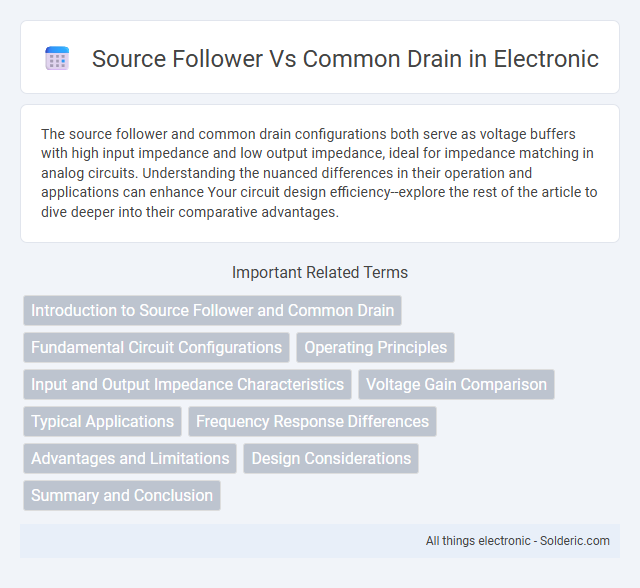The source follower and common drain configurations both serve as voltage buffers with high input impedance and low output impedance, ideal for impedance matching in analog circuits. Understanding the nuanced differences in their operation and applications can enhance Your circuit design efficiency--explore the rest of the article to dive deeper into their comparative advantages.
Comparison Table
| Feature | Source Follower | Common Drain |
|---|---|---|
| Definition | Amplifier stage where output is taken from the source terminal of a transistor | Field-effect transistor (FET) configuration with drain terminal connected to supply and output at source |
| Primary Device | Bipolar Junction Transistor (BJT) | Metal-Oxide-Semiconductor FET (MOSFET) |
| Voltage Gain | Approximately unity (close to 1) | Approximately unity (close to 1) |
| Input Impedance | High input impedance | Very high input impedance |
| Output Impedance | Low output impedance | Low output impedance |
| Phase Relationship | No phase inversion (output in phase with input) | No phase inversion (output in phase with input) |
| Common Applications | Buffer stages, impedance matching, voltage followers in BJT circuits | Voltage buffer, impedance matching in MOSFET circuits |
Introduction to Source Follower and Common Drain
Source follower and common drain are two configurations of field-effect transistors (FETs) commonly used in amplifier and buffer circuits. Both topologies feature the drain terminal connected to the power supply or load, while the output is taken from the source terminal, providing voltage gain close to unity and high input impedance. These configurations are favored for their ability to provide impedance matching and signal buffering without significant voltage amplification.
Fundamental Circuit Configurations
Source follower and common drain are fundamental MOSFET circuit configurations used for voltage buffering and impedance matching in analog electronics. The source follower provides a unity voltage gain with high input impedance and low output impedance, making it ideal for signal buffering. Your circuit benefits from the source follower's stable voltage transfer and minimal signal distortion compared to other amplifier stages.
Operating Principles
The source follower and common drain configurations both operate as voltage buffer stages, providing high input impedance and low output impedance by using a transistor with the output taken from the source terminal. The source follower employs a field-effect transistor (FET) where the source voltage follows the gate voltage minus a threshold, ensuring minimal signal loss and stable gain near unity. Your circuit benefits from the common drain's ability to maintain voltage stability while driving low impedance loads, making it ideal for impedance matching and signal buffering applications.
Input and Output Impedance Characteristics
The source follower, also known as the common drain configuration, features high input impedance and low output impedance, making it ideal for impedance matching and buffering applications. Your circuit benefits from minimal voltage drop across the device since the output voltage closely follows the input voltage. These impedance characteristics enable efficient signal transfer without loading the preceding stage, preserving signal integrity in analog circuits.
Voltage Gain Comparison
The voltage gain of a source follower and a common drain configuration is approximately unity, but the source follower offers slightly less voltage gain due to the source degeneration effect. Common drain amplifiers provide high input impedance and low output impedance, making them ideal for impedance matching with minimal voltage loss. Your choice between the two should consider the minor voltage gain differences alongside their impedance characteristics for optimal circuit performance.
Typical Applications
Source follower and common drain amplifiers are functionally identical, both widely used as voltage buffers in analog circuits to provide high input impedance and low output impedance. Typical applications include impedance matching, signal buffering in audio devices, and as output stages in operational amplifier circuits to drive low impedance loads without significant signal loss. You'll often find these configurations in sensor signal conditioning, where preserving signal integrity is critical.
Frequency Response Differences
Source follower and common drain configurations, often interchangeable in terminology, exhibit distinct frequency response characteristics due to their device implementations--source followers typically refer to BJTs, while common drain circuits employ MOSFETs. You can expect the source follower to have faster transitions and higher cutoff frequencies owing to the bipolar transistor's higher transconductance compared to the MOSFET's common drain stage, which excels in voltage buffering but with generally lower unity-gain bandwidth. Frequency response in these circuits is critical when designing amplifiers or impedance-matching networks, with source followers suitable for high-frequency applications and common drain stages favored for stability and linearity at moderate frequencies.
Advantages and Limitations
The source follower and common drain configurations both offer voltage buffering with high input impedance and low output impedance, making them ideal for impedance matching in analog circuits. The source follower provides excellent linearity and voltage gain close to unity but suffers from a limited voltage swing due to the threshold voltage drop. Your choice depends on balancing the benefits of low output impedance and the need to accommodate signal voltage ranges within device constraints.
Design Considerations
Source follower and common drain configurations primarily differ in current flow direction and biasing requirements, impacting their design considerations. Source followers demand careful biasing to optimize voltage gain close to unity and minimize output impedance for effective buffering. Common drain circuits require attention to transistor threshold voltage and load conditions to ensure linear operation and stable voltage regulation in analog applications.
Summary and Conclusion
The source follower and common drain configurations both function as voltage followers, providing high input impedance and low output impedance, making them ideal for impedance matching and buffering applications. Source followers typically use BJTs, while common drains employ MOSFETs, with the latter offering lower power consumption and better thermal stability. Your choice depends on the specific circuit requirements, such as device availability, power efficiency, and desired voltage swing.
Source follower vs Common drain Infographic

 solderic.com
solderic.com